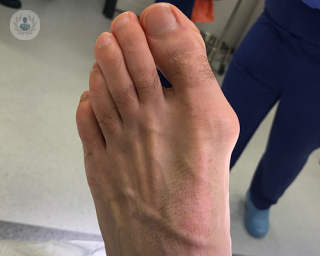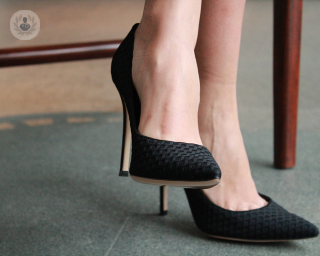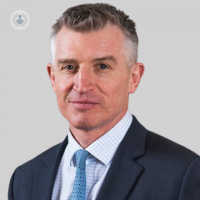What is minimally invasive surgery for bunions?
Minimally invasive bunion surgery, also known as percutaneous surgery for bunions, is a novel technique for treating bunions. It is performed as a day case procedure. Although it can be done under local anaesthesia, most patients will have a short anaesthetic or sedation.
Minimally invasive surgery for bunions is an alternative to open surgery which has several advantages:
- small incisions
- less post-operative pain
- less stiffness
- improved and short post-surgical recovery
- increase in patient satisfaction and confidence

Why is it done?
Minimally invasive surgery for bunions is generally indicated for those cases in which attempts to treat the pain with conservative medical treatments (anti-inflammatory agents, splints, corrective footwear) have been unsuccessful, with pain persisting or increasing, making it difficult to walk.
Conservative medical treatments are not effective in severe cases. This is why it is important to consult with an orthopaedic specialist when the first symptoms appear.
What does it involve?
This type of surgery involves making small skin incisions, around 5mm in length, then introducing small instruments. The bone is divided through these incisions, the position corrected and then fixed with screws. The patient can return home on the same day and will be able to take weight through the foot immediately.
Care following the intervention
After the procedure, orthopaedic footwear, a special shoe, will be worn. You are then allowed to place weight on the foot.
- 1st week: you will have a big bandage on your foot and will able to walk but should be resting most of the time
- 2nd week: you can increase the walking if the skin has healed, however, during the first month you will need the post-surgical shoe
- 2nd month: you can start to wear a comfortable shoe, such as trainers or sandals, and walk normally
Minimally invasive bunion surgery
Mr John McKinley - Orthopaedic surgery
Created on: 11-13-2012
Updated on: 09-05-2023
Edited by: Sophie Kennedy
What is minimally invasive surgery for bunions?
Minimally invasive bunion surgery, also known as percutaneous surgery for bunions, is a novel technique for treating bunions. It is performed as a day case procedure. Although it can be done under local anaesthesia, most patients will have a short anaesthetic or sedation.
Minimally invasive surgery for bunions is an alternative to open surgery which has several advantages:
- small incisions
- less post-operative pain
- less stiffness
- improved and short post-surgical recovery
- increase in patient satisfaction and confidence

Why is it done?
Minimally invasive surgery for bunions is generally indicated for those cases in which attempts to treat the pain with conservative medical treatments (anti-inflammatory agents, splints, corrective footwear) have been unsuccessful, with pain persisting or increasing, making it difficult to walk.
Conservative medical treatments are not effective in severe cases. This is why it is important to consult with an orthopaedic specialist when the first symptoms appear.
What does it involve?
This type of surgery involves making small skin incisions, around 5mm in length, then introducing small instruments. The bone is divided through these incisions, the position corrected and then fixed with screws. The patient can return home on the same day and will be able to take weight through the foot immediately.
Care following the intervention
After the procedure, orthopaedic footwear, a special shoe, will be worn. You are then allowed to place weight on the foot.
- 1st week: you will have a big bandage on your foot and will able to walk but should be resting most of the time
- 2nd week: you can increase the walking if the skin has healed, however, during the first month you will need the post-surgical shoe
- 2nd month: you can start to wear a comfortable shoe, such as trainers or sandals, and walk normally


Bunions: why they happen and how to get rid of them
By Mr Stefan Weitzel
2024-12-21
Bunions have the power to negatively impact several aspects of people's quality of life. Fortunately, this common problem can be successfully treated. Mr Stefan Weitzel provides you with a full explanation on why bunions happen and how to get rid of them. See more


All about minimally invasive bunion surgery
By Mr Adam Ajis
2024-12-20
Leading orthopaedic surgeon Mr Adam Ajis provides a detailed insight to minimally invasive bunion surgery in this informative article. See more


Bunion overview - causes, risk factors and your treatment options
By Mr Henry Willmott
2024-12-20
Around 80% of bunion cases are seen in women. The condition is typically exacerbated by wearing shoes that are too small or excessively high heels that force the toes into the end of the shoe. Mr Henry Willmott explains in this article how to relieve bunion pain, reduce your risk of one developing and what treatment options are available. See more


Minimally-invasive bunion surgery: An expert guide
By Mr John McKinley
2024-12-19
Highly respected consultant orthopaedic surgeon Mr John McKinley, who specialises in foot and ankle surgery, sheds light on what to expect from minimally invasive surgery for bunions in this informative article for patients. See more
Experts in Minimally invasive bunion surgery
-
Mr Rohit Madhav
Orthopaedic surgeryExpert in:
- Sports traumatology
- Minimally invasive bunion surgery
- Ankle arthroscopy
- Tendon injuries
- Foot fracture
- Bunion (hallux valgus)
-
Mr David Redfern
Orthopaedic surgeryExpert in:
- Arthritis
- Sports injuries
- Minimally invasive bunion surgery
- Bunion (hallux valgus)
- Ankle replacement surgery
- Ankle arthroscopy
-
Mr Stephen Bendall
Orthopaedic surgeryExpert in:
- Foot and ankle
- Ankle arthroscopy
- Arthritis
- Minimally invasive bunion surgery
- Sports injuries
- Flat feet
-
Mr Samer Morgan
Orthopaedic surgeryExpert in:
- Ankle replacement surgery
- Foot and ankle
- Achilles tendon
- Minimally invasive bunion surgery
- Joint injections
- Sports injuries
-
Mr Adam Ajis
Orthopaedic surgeryExpert in:
- Arthritis
- Minimally invasive bunion surgery
- Foot and ankle
- Ankle arthroscopy
- Ankle replacement surgery
- Bunion (hallux valgus)
- See all

The Chaucer Hospital - part of Circle Health Group
The Chaucer Hospital - part of Circle Health Group
Nackington Rd, Canterbury CT4 7AR,
No existe teléfono en el centro.
By using the telephone number provided by TOP DOCTORS, you automatically agree to let us use your phone number for statistical and commercial purposes. For further information, read our Privacy Policy
Top Doctors

The Park Hospital - part of Circle Health Group
The Park Hospital - part of Circle Health Group
Sherwood Lodge Drive, Burntstump Country Park, Arnold, Nottinghamshire NG5 8RX
No existe teléfono en el centro.
By using the telephone number provided by TOP DOCTORS, you automatically agree to let us use your phone number for statistical and commercial purposes. For further information, read our Privacy Policy
Top Doctors

Goring Hall Hospital - part of Circle Health Group
Goring Hall Hospital - part of Circle Health Group
Bodiam Ave, Goring-by-Sea, Worthing BN12 5AT
No existe teléfono en el centro.
By using the telephone number provided by TOP DOCTORS, you automatically agree to let us use your phone number for statistical and commercial purposes. For further information, read our Privacy Policy
Top Doctors
-
The Chaucer Hospital - part of Circle Health Group
Nackington Rd, Canterbury CT4 7AR,, CanterburyExpert in:
- Hip
- Cataracts
- Orthopaedic surgery
- Ophthalmology
- Knee
-
The Park Hospital - part of Circle Health Group
Sherwood Lodge Drive, Burntstump Country Park, Arnold, Nottinghamshire NG5 8RX, ArnoldExpert in:
- General Surgery
- Maxillofacial Surgery
- Oral surgery
- Plastic surgery, reconstructive and aesthetics
- Obstetrics and Gynaecology
- Podiatry
-
Goring Hall Hospital - part of Circle Health Group
Bodiam Ave, Goring-by-Sea, Worthing BN12 5AT, Goring-by-SeaExpert in:
- Hip
- Cataracts
- Gallbladder surgery
- General Surgery
- Orthopaedic surgery
- Hernia
- See all
- Most viewed diseases, medical tests, and treatments
- Ulnar nerve entrapment
- Peripheral nerve block
- Peripheral neuropathy
- Joint pain
- Lumbar herniated disc
- Spinal surgery
- Minimal access surgery (keyhole surgery)
- Shoulder pain
- Osteoporosis
- Botulinum toxin (Botox™)








